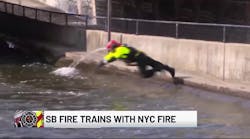This University of Extrication column is the second in a multi-part series presenting advanced technician-level vehicle rescue training scenarios. This article describes a challenging vehicle rescue evolution that meets the criteria of a technician-level skill and competency of NFPA Standard 1670.
Opening the Floor of a Side-resting Vehicle
This scenario requires a team to work only from the undercarriage area of a side-resting vehicle. From that vantage point, the team must make an opening in the floorboard of the vehicle of sufficient size that every member of the team can climb through it and come out from the other side. Whether a rescue team would ever have to do this at a real crash scene is not the point. The point is that many crashes have occurred where the team was required to make openings in the underside of the vehicle to access trapped patients or to at least free them enough to be extricated from the roof side of the vehicle.
To set up for this scenario, a vehicle must be placed on its side, preferably with the driver’s side down. The simulation is that a person, a driver, is trapped inside. Rescuers must make an opening in the floorboard to access this “patient.” For training purposes, everyone will climb through the hole when it is completed.
A four- to six-person team should be capable of accomplishing this task in 12 minutes or less. The strategy is to first stabilize the side-resting vehicle, then breach the floorboard. The most effective stabilization tactic is to utilize a tensioned buttress stabilization system. The vehicle must be assured to be “rock solid” stable without a doubt. Due to the work that will be done to it, if it is the least bit unstable at the beginning of the evolution, there will be problems during the floor-opening work.
The tactics for creating the opening in the floorpan of the vehicle include cutting your way or prying your way through the floorboard structure. You will be dealing with various thicknesses of metal, along with an assortment of items such as the frame or uni-body structure, exhaust system, drive shaft, steel tube lines and cables, carpeting and insulation, bolts and brackets. The best results come from a combination of cutting and prying your way through this material.
The floorboard opening procedure must begin with an undercarriage size-up. You need to find the weakest “link.” The weakest point on the floorboard of a sedan vehicle is typically the area where the rear-seat passengers place their feet. This area generally consists of just a metal floorpan and some carpeting. This is not true, however, with all vehicles, especially minivans with the new stowable seat or cargo area in the floorboard. Once your weak area is located, it may be a relatively easy area to make a two-by-six-foot opening rather than a square two-by-two-foot opening. It’s your call. You have to get every member of your team through the opening, so consider that when planning your work.
Next, remove exterior objects that are in your way (i.e., drive shaft, exhaust system, cables and wires). Once clear, familiarize yourself with the features of the underside of the vehicle. Look for landmarks such as the seat-track mounting bolts, seatbelt anchor bolts, portions of the uni-body frame of the vehicle, as well as any structural cross-brace members.
Once the area you intend to breach is identified, an initial “punch hole” is needed as a starter point for the floor opening. Use a pick-headed axe or a halligan-type tool for this. From that initial hole, you can enlarge your opening by cutting with an air chisel or reciprocating saw, for example. The alternative is the “brute force” method, which involves sticking the tips of a power spreader into the starter opening and simply tearing the floorpan apart.
Once the metal floor is removed, cut away any carpeting, insulation and electrical wiring you may run into. Move any interior components such as a seat or seat cushions to clear your opening even further.
Bend the sharp or ragged edges of the opening in toward the interior of the vehicle. This will minimize snagging on turnout gear as you crawl through. You can use the carpeting to “pad” the edges as well.
Each member of the team must then climb through the hole and exit from inside the vehicle. Use a top-side door or a broken-out rear window, for example, to get out of the vehicle.
There is a safety caution worth repeating because of the side-resting vehicle: Rescue personnel should never kneel when working close to a side-resting vehicle. Always maintain a squat position; bend at the knees. With this posture, if the vehicle would shift or a tool slip or fail, you are in a better position to spring away from the hazard. If you are kneeling with your knees touching the ground, you’ll be trapped!
TASK: Given a side-resting vehicle with a simulated person trapped inside, work only from the undercarriage side to make an opening in the floorboard sufficient in size for every member of the team to climb through the opening and exit the vehicle from the other side.
Ron Moore, a Firehouse® contributing editor, is a battalion chief and the training officer for the McKinney, TX, Fire Department. He also authors a monthly online article in the Firehouse.com “MembersZone” and serves as the Forum Moderator for the extrication section of the Firehouse.com website. Moore can be contacted directly at [email protected].








